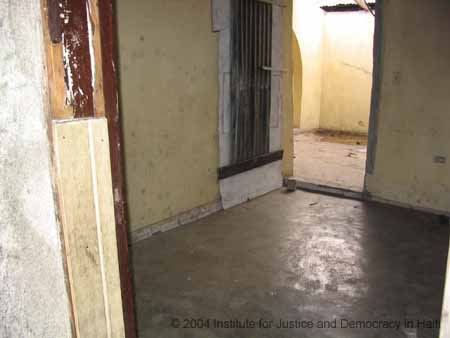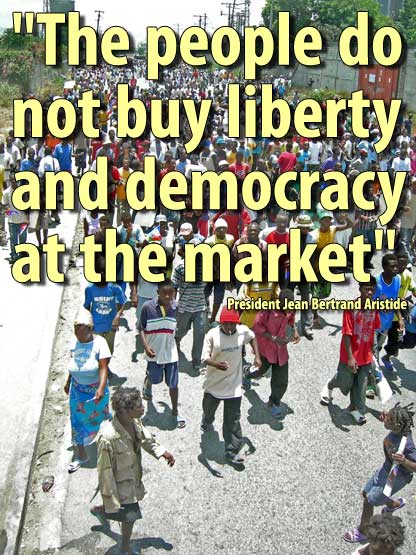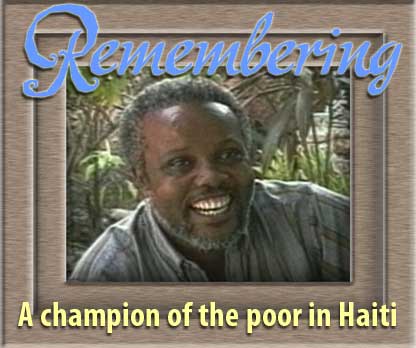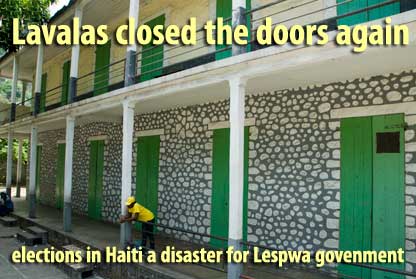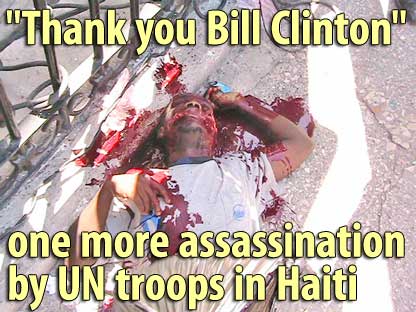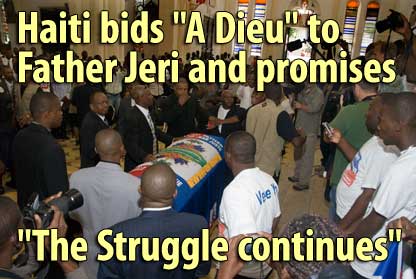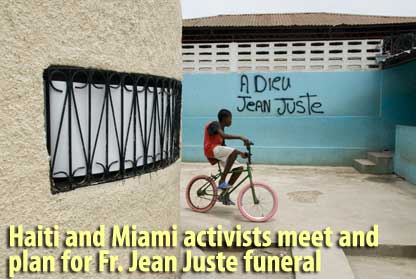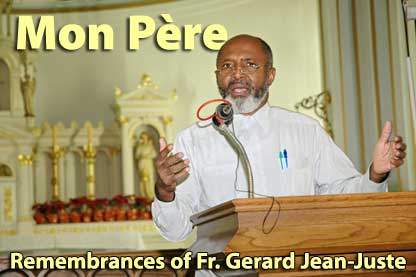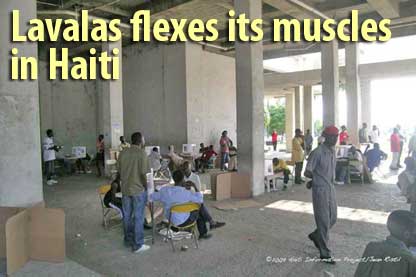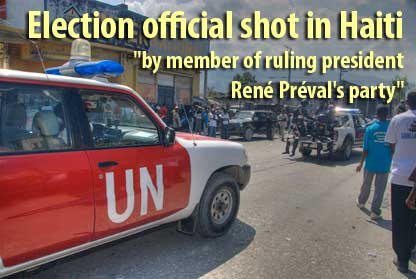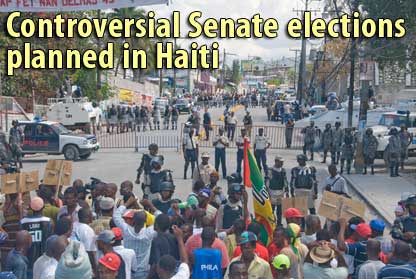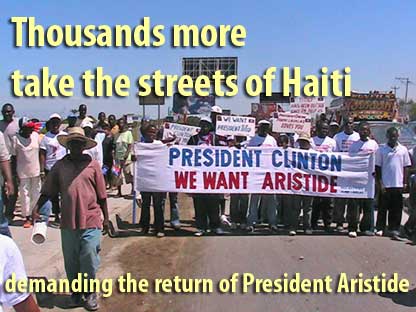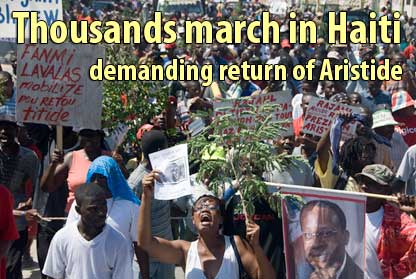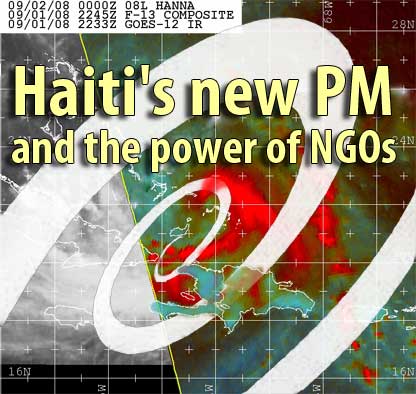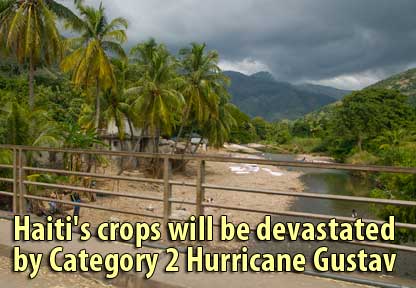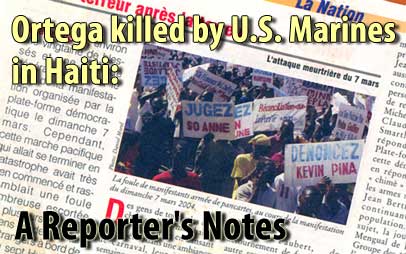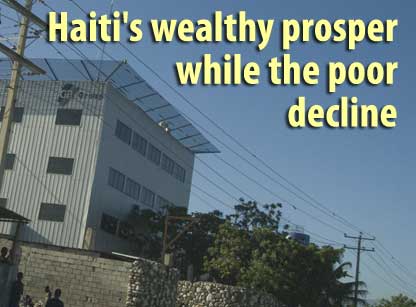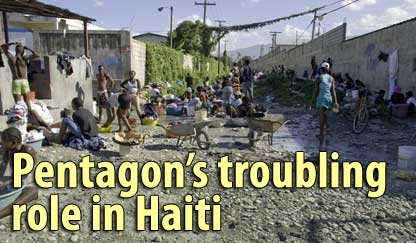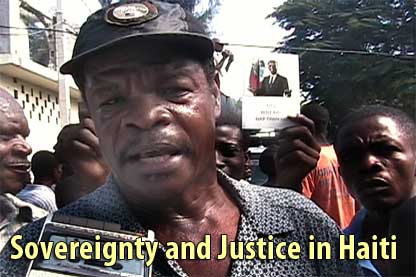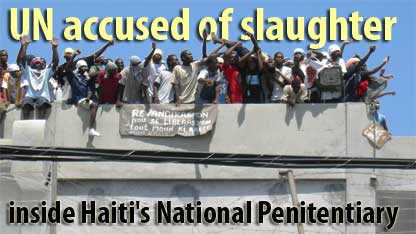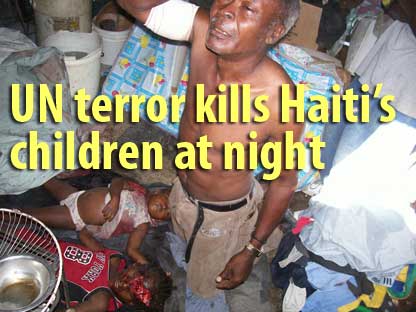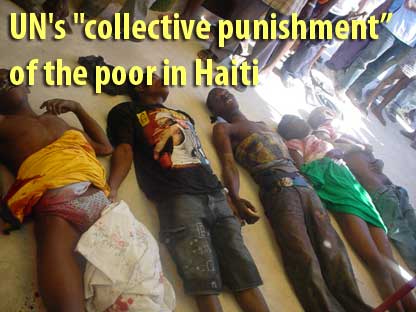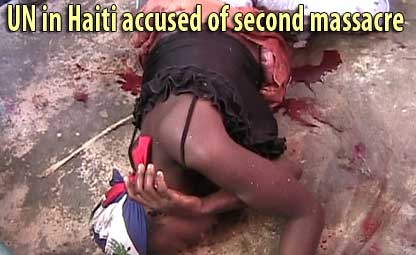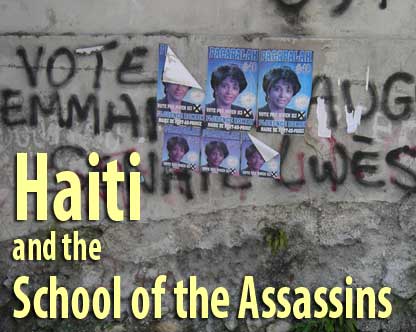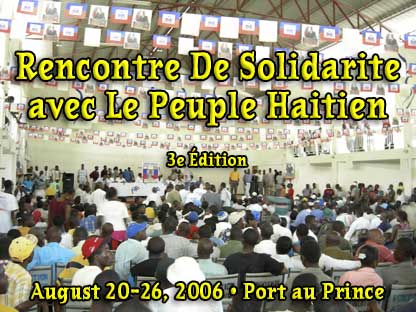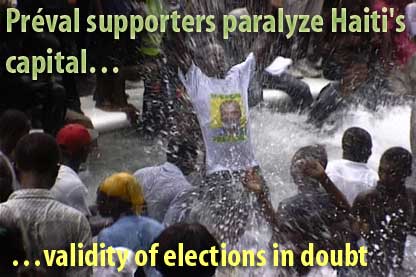Human Rights in Haiti
February - May 2004 |
News HaitiAction.net
|
||||
BOOKMARK
Haiti Action.net
Tropical Cyclone Page
For the 2009 Hurricane Season
resources and updates
Human Rights Violations in Haiti
February - May 2004
Report Date: July 19, 2004
This document contains a partial list of human rights violations reported to the staff of the Institute for Justice and Democracy in Haiti (IJDH) from the end of February until mid-May 2004. The report focusses on attacks against grassroots activists and residents of poor urban and rural areas in Haiti, the type of victims whose stories are often overlooked in reporting on Haiti.
The report contains several graphic photographs of victims of human rights violations. Although the photographs are disturbing, they are accurate reflections of Haiti's extremely disturbing reality. By presenting the situation in its entirety, we hope to decrease the chances that others will suffer the same fate.
IJDH was founded to respond to February's violent interruption in Haiti's democratization process. Its mission is to work with the people of Haiti in their non-violent struggle for the return and consolidation of constitutional democracy, justice and human rights, by distributing objective and accurate information on human rights conditions in Haiti and cooperating with human rights and solidarity groups in Haiti and abroad. IJDH's website, www.ijdh.org, will be on-line soon, but in the meantime, for more information about the organization or this report, please contact IJDH's director, Brian Concannon Jr., at Box 745, Joseph, OR 97846, brianhaiti@aol.com, or 541-432-0597.
The following apply to the contents of this document:
1. When information was received from indirect sources, efforts have been made to meet with relatives of victims killed or who have disappeared in order to corroborate the reports. When available, copies of official documents (very few) and pictures were obtained to further confirm that the violations had effectively taken place. When it has not been possible to obtain direct testimonies or other evidence to confirm the facts reported, the names of alleged victims are followed by one asterisk sign (*).
2. Although the majority of interviewees are from the poorest areas of Port-au-Prince, it has been possible to meet with persons in hiding from the Central Plateau and other regions in the capital city. With the exception of four (4) victims and for those whom it has not been possible to obtain their identity, interviewees have reported that the victims were supporters of President Aristide or Haiti's former constitutional government.
3. The names of certain victims have been withheld from this report and only their initials used either at their own request or because of the risk the publication of their names may pose to their security or to that of their families. The original documentation of all interviews are available.

Executed victims among dead bodies piling up at the General Hospital's morgue, May 20, 2004.
4. Cases reported in this document are only a tiny fraction of the violations committed during the period covered. This is because:
a) many victims or relatives of victims have gone into hiding and it has not been possible to meet with them;
b) most of those we met with were living in Port-au-Prince; the continuing control of areas outside Port-au-Prince by rebels of the Front and former soldiers did not permit meetings with victims in these parts;
c) many victims or their relatives decline to report violations for fear of further retaliation;
d) cadavers brought to the morgue and unclaimed are systematically disposed of by burning, burial or dumping in areas where they are eaten by pigs or dogs. One of the main dumping grounds, Titanyen, was used as a dumping place for victims of the 1991-1994 de facto military dictatorship and the Duvalier dictatorship;
e) this investigation was not able to address many categories of violations during this period, especially the numerous arbitrary arrests and detentions that were being reported, due to the circumstances and political context during which the investigation was carried out.
Killings and disappearances
Although it is possible that many of those who have been reported missing will turn up alive in the near future, this seems improbable since in most cases family members have made all relevant searches without success. Interviewees have repeatedly declared that those persecuted are unable to go into hiding in the countryside due to the fact that armed former soldiers and other opponents of the constitutional government are in control there. Many of the people that would ordinarily give them shelter have themselves been forced to come into hiding in Port-au-Prince.
Morgue employees from the General Hospital in Port-au-Prince have revealed that 800 bodies on Sunday, March 7, and another 200 bodies on Sunday, March 28 were dumped and buried in a mass grave at Titanyen. These figures are unusual for such a short period of time (100 is normal for a month). Moreover a request to have the identify of these dumped persons ascertained was refused by the morgue director.
FEBRUARY (28 and 29 only)
On February 28, Gerard Jean Juste left his niece's house at around 2.00 pm and has not been seen since, as of May 20., despite searches of hospitals, prisons and morgues.
Nancy Borgella, 21 years old and the mother of two children (9 months and 6 years), was last seen by her mother on February 28. Her dead body was found near the Chancerelles Hospital (Pont Rouge, close to Cité Militaire) on March 1, her left hand cut off, her neck swollen and her tongue hanging out. It is believed she had been locked and left to suffocate to death in a container.
Three victims were members of OAC (Organisation des Adultes de Canapé Vert), which is affiliated with the Fanmi Lavalas party: Alsinous Calixte (50-55) was last seen on February 28 after he left his house upon hearing that one member of his organization had been killed; Muqader Milort (56), another OAC member , was last seen on February 28; Jean Gouleme (49) left his house on February 29 around 7 am and has not been seen since. All searches in relevant places to find these three disappeared have been unsuccessful as of May 20.
Roosevelt Dumond, 22 years old, was shot several times and killed on February 29 at Martissant, allegedly by two policemen named Masillon and Belony. Relatives report that several other persons were killed by gunshots in the area on that same day when they were demonstrating against the departure of President Aristide from office.
Thomas Dominique, 19 years old, was shot three times and killed when he was out on the street at Martissant 15 where demonstrators were out protesting the departure of President Aristide. His body was afterwards dragged all the way to Fontamara 43 and left there.
Anya Pluvieuse, 70, died after a group of unidentified men grievously assaulted her when they allegedly came to look for Lavalas supporters in Delmas 4, an area known for its pro-Lavalas stance. Anya Pluvieuse was unable to escape with other residents and was later found bleeding from the mouth by her relatives, and died of her injuries on her way to the hospital;
Porlouis Esprinol (43), a delegate of a popular organization and a Lavalas activist, was shot and killed in Carrefour Boston, Cité Soleil.
At Rue Saint Martin, a white pick-up with four men on board, two dressed in police uniforms and the other two in red T-shirts, jeans and bullet-proof vests shot at passers-by. A pregnant woman* and a man named Zigi*were shot and killed. D.M. (14) was shot and wounded.
Pierre Lucin Antoine was shot and died 4 days later of his wounds. It was not possible to bury him for lack of financial means and his body was left at the General Hospital morgue for disposal.
Robert Mirlat (21) disappeared on February 29 after he left a demonstration protesting the departure of President Aristide to go to his house to protect his wife and children. On March 1, his dead body was found at Piste Aviation, an old airport used as a cadaver disposal site. The body could not be taken away as those who went there to look for him fled when they heard that rebels of the Front were coming in Port-au-Prince. On March 3, Mirlat's family learned that his body was at the morgue of the Hopital Général, but when they went there they were refused permission to see the body on the ground that they would use it for demonstration purposes.
A picture taken of Robert Mirlat's body dumped at Piste Aviation: his feet had been amputated and deep wounds inflicted on his left thigh
Beauté Anevil (30) disappeared after participating in a pro-democracy demonstration. Despite persistent searches by his family he has still not been found as of May 20.
Roody Mogé* from Fort National has not been seen since February 29 (as of_May 20) after he joined those who were protesting the departure of President Aristide. He was an engaged Aristide and Lavalas supporter.
Wisly Francique*, a student member from Carrefour, has been missing since February 28. Wisly was a member of the Collectif Etudiants Haitiens, a student movement supporting the Lavalas regime and President Aristide.
March
Villan Louis was last seen in the week following February 29 participating in a peaceful march in support of President Aristide in Bel Air near the Perpétuel Church. The demonstration was stopped by the arrival of US Marines. Gunshots were fired and many demonstrators fled to hide in nearby residentsâ houses. Villan Louis has not been seen since and searches for him at hospital morgues and prisons have been fruitless as of May 20.
On March 1, Wilner Charles, an active Aristide supporter, left his house in Carrefour Feuilles and has not been seen since. Gunshots were heard in the area at the time of the disappearance. Searches have been made in morgues and prisons but have been unsuccessful.
March 1: Jasmy Emmanuel, 26 years old, has not been seen since March 1st after he left his home. He had earlier participated in a demonstration against the departure of President Aristide in front of the National Palace. Searches for him have been made without success at the main prisons and hospital morgues as of May 20.
Nono Charles was last seen by his family on March 1. His decomposed body was found on March 4 on a pile of garbage near the market in the port area, his body mutilated by machete blows.
March 1: An Aristide and Lavalas supporter in hiding in Port-au-Prince reported that Junior Benjamin* and Castra Frantz* (members of Ti Fanmi Lavalas Commune de Moron, a local political organization) have been killed by opposition supporter Crislaine Cadet in Moron, Jeremie.
March 1: Philippe* (last name unknown) was shot and killed when armed group in hoods and full military gear shot at the crowd during a demonstration in Bel Air, held to protest the departure of Aristide from office. It has been reported that many persons were killed during the same attack but their identities remain to be ascertained.
March 1: Emmanuel Nelson (27) and Claudy Nelson (29), two friends from Carrefour, both members of a "rara" musical band called BOURARA, were kidnapped by a group of men that included some in police uniforms. Searches were made for them at the local police station but they could not be found there. After hearing that there were dead bodies in a place called Mariani, near the old railroad tracks, their relatives went there and found them with their hands tied behind their back. Emmanuel was shot between the eyes and Claudy killed by machete. The relatives could not take the bodies on that day because of the ongoing violence in the area and when they returned the next day, they saw that the bodies had been burned. Three other unidentified bodies were in the same site where Emmanuel's and Claudy's bodies were found.
March 2: Guillaume Jean (70), a Lavalas supporter from Cité Soleil, left his house on March 2 and has not been seen since, as of May 20.
March 2: Atit Espérance (15) from Carrefour disappeared after he left his home for the local market. His mother has looked everywhere for him but he has not been found as of May 20. Gunshots were repeatedly fired that day in the area, reportedly killing many people.
March 2: André Edward (18) was shot twice in the back and killed after he left a place called Grand Village in Cité Soleil to go back to his house around 7 p.m. André was a Fanmi Lavalas activist and had participated in various activities in support of President Aristide. It has not been possible to determine who were his killers but it has been reported that he had been verbally abused several times immediately before his killing because of his political affiliation. His mother is a member of MOFAVA, a women's association closely associated with Fanmi Lavalas, and is now living in hiding, in fear for her life.
March 3 - the bodies of Rodrigue* and Fito Saintille*, both Lavalas supporters, were discovered under the Carrefour Bridge. It has not been possible yet to determine when they disappeared.
March 4: Wilfrid Thomas* and Kenold Jean* were kidnapped at Ruelle Saint Legere, 4ème Avenue (Martissant) by hooded men dressed in black driving in two cars. Their whereabouts are still unknown, as of May 20.
March 7: Francillon Auguste, 52 yrs old, a member of Tèt Ansam St Jean Bosco and the Aristide Foundation for Democracy, was left in Grande Rue (4ème) severely beaten up. He later died of his injuries on March 10 in Cap Haitien where he was taken to be treated.
March 8: Ulrick Labadie from Croix des Missions was kidnapped from a private car at Route Nationale 2 and has not been seen since as of May 20. Searches at prisons and morgues have been carried out. At the time of his kidnapping, Ulrick was wearing a T-shirt adorned with a picture of President Aristide.
March 10: In Moron, Jeremie, Ricardo Bonnet was kidnapped from the house of a friend where he was hiding and brought to a nearby river where he was killed by machete blows and buried nearby by a group of men, including Toutou (alias), reportedly associated with the opposition to the Aristide government. Fritz Lauchard* and Babo Jean Philippe*, both from the same area, were killed by a certain Frantz (full name unknown) also said to be closely associated with the former opposition;
March 11: Paul Saintil, 42 years old, was shot in the mouth and killed by a group of men who came looking for him at his house in Delmas 48.
March 12: Momeline Milate, 29 years old, a mother of a 10 year old child, was outside her house and selling gasoline when she was shot 3 times and killed by unidentified armed and hooded men driving in a pickup in Delmas 4. Momeline was not involved in any political activities according to her relatives but Delmas 4 is an area known for its high level of support to President Aristide.
March 12: Louis Frantzy (alias Papouche) (18) and Rony Ippolyte (alias Pastè) (30) were shot and killed, reportedly by US Marines in an operation conducted near l'Eglise Perpétuel in Bel Air where the majority of residents support President Aristide. It has been reported that on that night several other persons were killed and their bodies taken away in black body bags - only those of Frantzy and Ippolyte were recovered and hidden. Other residents were shot and wounded during the same operation.
March 17: Wilton Frederic* from Rue Jalousie (Petion Ville) has been missing since that date as of May 20.
On March 17 : Roosevelt Rousseau (alias Vével) (42), a partisan of President Aristide and member of a popular organization, ROC (Rassemblement d'Organisations pour le Changement), was shot 8 times and killed while he was sitting outside his house with his family by 6 members of an armed gang called Base D'Enfer. Base D'Enfer is based in Carrefour 3, Delmas 4. The killers left while threatening to come back to get the victim's son "because he will grow up to become an Aristide supporter as well." His parents, his wife and 4 children are now living in hiding. The armed men who came to kill Vevel reportedly included Jean Ronald, Ti Tonton, Chov, Sonson and two other unidentified men.
Vevel after his execution by gunshots on March 17, 2004 in front of his house.
March 17: Florin Dorcir* (35 yrs old), a police Inspector, was shot and killed at Rue du Champs de Mars. [Le Nouvelliste, Obituaries, 30 Mars 2004].
March 18: Gregory Tassy Louis*, a Fanmi Lavalas partisan, was kidnapped from a taxi in Avenue John Brown and killed by two gunshots in the head [Le Nouvelliste, Obituaries, 30 Mars 2004].
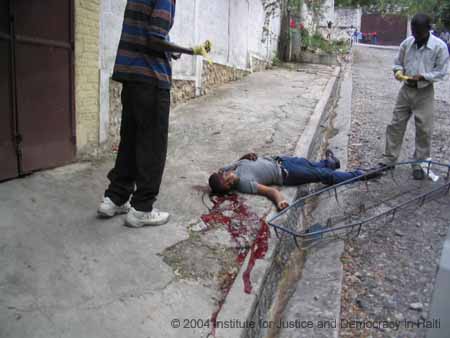
March 18: A man was brought by car in Pacot, executed by a gunshot to the head and dumped on the street. The police acknowledged his killing but have refused to reveal the identity of the killed man.
March 19: Josette Dena (21) left her house at 1.30 pm and has not been seen since. Josette was not politically active but her grandmother is a member of MOFAVA, a women's organization closely associated with Fanmi Lavalas. Efforts to find her have been without success as of May 20.
March 20/21: Pierre Dorcéan (24 yrs old), Pierre Monel (22 yrs old), Emmanuel Deronvil (21), Abel Cherenfant (23) and Ti Wens (16), all Lavalas supporters, were taken to the Cafeteria Commissariat by 5 police officers identified as being part of a group named "5 pou l'Enfer" ("5 from Hell", one of them is named Belo) from the Cafeteria Commissariat. When their families went to look for them there, they were told that they were not there but another police officer has allegedly confirmed that they were there and that they were dead. Two of the bodies were eventually found at Rue des Cesars in downtown Port-au-Prince, another two in Grande Rue and one in Rue des Fronts Forts. Two other bodies were later recovered from Piste Aviation. All victims had black bags over their heads and their hands tied behind their backs. The police officers involved in the killings have been arrested.
After the funeral of the victims, mourners demonstrating for justice in front of the Commissariat were fired upon by police officers who were inside.
It was reported that on March 21/22, more than 40 bodies had been dumped at a place called Piste Aviation in Delmas 2. An investigation carried on March 30 revealed that the bodies had been burned some days after they were dumped: ashes as well as some skulls and bones were discovered at the site where the bodies had been burned and pigs were seen eating the remains off some bones lying around. According to witnesses, many of the those killed were hooded and had their hands tied behind the back.
March 25: the bodies of Jean Robert* and Kenzy Joseph*, two members of a popular organization and supporters of Fanmi Lavalas, were found by their mother at Piste Aviation.
March (exact date unknown): Tisma Angelot*, member of a student organization GRERU (Groupe de Reflexion Pour la Réouverture de L'Université) close to Aristide's regime, was shot and killed at Route Aéroport (Delmas) by unidentified armed men on foot.
March (exact date unknown): Descombes* was reported shot and killed by members of a gang named Base D'Enfer from Delmas 4. The gang is said to be closely associated with the former opposition and opposed to President Aristide. The leader of the gang is known as Pepa and he is the brother of a former soldier who is also a member of the gang.
APRIL
April 1: Getro Assanise was shot and fatally wounded (he died on May 14) by 2 armed gang members, Ti Moise and Kete, at his employer's shop. The killers were looking for Assanise's employer and his son, two Fanmi Lavalas activists in Bel Air. The son was attacked and shot (but not wounded) at on March 3 by a group of armed men in a white jeep asking for his father.
April 4: Philippe Eliphete, a "hougan" (voodoo priest) and Fanmi Lavalas activist was shot by a group of 3 armed men in 5ème avenue, Martissant. He died on his way to the hospital. The shooting was carried out by a gang. The leader of the gang is known as Ti Junior and is said to have escaped from the National Penitentiary on February 29. Ti Junior reportedly intervened on Radio Caraibes on March 1 to offer his assistance to police officers to arrest Lavalas "chimè" (a term normally used to refer to common criminals but purposefully used to refer to Lavalas supporters in poor neighborhoods). Other known members of the gang are Ti Claudy; Ti Jacques; Jackson; Ti Frè and Bwa Wòn.
It has also been reported that after Eliphete's death, Estarien Augustin, a former member of FRAPH (paramilitary group responsible for numerous human rights violations during the 1991-1994 military regime), has forcefully removed Eliphete's possessions from his voodoo temple and has been occupying the building since.
April 4-5: Reynold (20) and Junior (22) Saintillus, two brothers and activists members of a pro-Lavalas popular organization were kidnapped at night by a group of armed men from the house where they were hiding in Croix des Bouquets. They were taken to a nearby river (Riviere Grise, Rémy) and killed by decapitation. When the bodies were found, both heads were missing. Among those who came to kidnap Reynold and Junior were former soldiers (including Rache Pwel, a notorious former soldier) and others believed to be Aristide opponents.
Junior Saintillus, decapitated during the night of April 4-5.
April 5: Teleco* and Johny Selange*, members of a popular organization affiliated with Lavalas in Martissant, were allegedly kidnapped by members of a rara musical band said to be close to the former opposition.
April 11: Hippie* was shot and killed by the same gang that killed Philippe Eliphete and Herold in Martissant. No arrests have been made despite the fact that the killers were present when members of the multinational force came to fetch the body.
On April 27 J.G., J.C. and A. left their homes in Linto (Cité Soleil) for La Saline and did not come back. On April 28, after searches were made, J.G.'s body was found at the General Hospital morgue. He had been shot in the temple and his face showed several machete wounds. It has been reported that J.C. had been killed too but his body has not been found. A. is in hiding and it has not been possible to meet with him. It is believed that a group of convicts who escaped from the National Penitentiary on January 1 are behind the killings. On April 18 they had assaulted J.G.'s brother by machete. After J.G. confronted some of them, he was threatened with death.
April 28-29: Jean Charles Emmanuel (22), an Aristide supporter, disappeared during the night. He was last seen by his brother who left him near Batimat near Cité Soleil. Searches made at hospitals, morgues, prisons and Titanyen for him have remained unsuccessful as of May 20.
MAY

© 2004 Haiti Information Project - all rights reserved - Titus Saintus killed by Haitian Special Forces at Lavalas Demonstration. This pro-Aristide demonstrator-Titus Simpton- was shot by Haitian Special Forces (SWAT) during the peaceful demonstration. He was shot 30 yards in front of the photographer who was shot at twice himself.
May 18: Simpson Saintus (alias Titus) was shot and killed in Bel Air by members of the Police SWAT team during a demonstration in support of President Aristide. A journalist trying to photograph the killers was shot at but was not injured.
May 19: Marc Oreste Jean Baptiste* from Delmas 1, a supporter of President Aristide was allegedly shot and killed at his workplace, a meat market in the city centre. Marc Oreste had worn a T-shirt with a picture of President Aristide to a demonstration on May 18 and had gone back to work afterwards still wearing the T-shirt. It is unknown who killed him.
On May 19, at around 8.00 pm at Pont Breard, Sou Dalles, Ti Moto* and Asibe* (otherwise known as Capois) were killed by Ti Junior in Martissant. Ti Junior and members of his gang, had killed two other men and seriously wounded another in the same area in April. After the killings, he allegedly declared that he had accomplished a mission and was seen distributing money to other gang members.
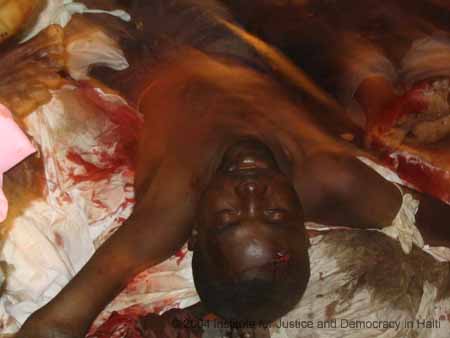
Ti Moto lying on top of a pile of bodies at the General Hospital's morgue, May 20.
On May 20, Ti Yves, Fenel (alias Nike) and Ti Fre (real name or alias is Alton) were shot at and killed in the same zone of Martissant. The first two bodies were seen lying in Corridor Lafoi and the other body in 4th Avenue. It is believed that these three persons killed were associated with Ti Junior and that they were killed in retaliation of the murders perpetrated with impunity by Ti Junior and his gang against Lavalas activists in the area in April (Philippe Eliphete and Hippie - see above).
Simpson Saintus being carried away by fellow demonstrators for fear his body is taken away
by the police and not recovered as has been the case for many other victims.
OTHER TYPES OF VIOLATIONS
PORT-AU-PRINCE
April 2: the building of STAM, (Syndicat des Travailleurs des Agences Maritimes - a labor organization within the National Port Authority (APN)) was shot at by armed civilians who included former employees of the APN, including Patrick Edma and Jean Robert Edma, said to be associated with the former opposition. Five employees were beaten up and one of them was stabbed and wounded. Others were shackled and held for several hours under the sun by US Marines who came on the scene. Many were afterwards taken and detained at various detention locations in Port-au-Prince. Several were released a few days later and one on April 12, without ever being charged.
April 3: Herold* (last name unknown), the driver of a Fanmi Lavalas Senator was shot in Martissant by members of an armed gang that had already killed several Lavalas supporters. A depot where he kept his sale products was burned during that night.
April 4: house of Fritz Noncent, former member of the Presidential Security Guard, in Grand Ravines, Martissant, was burned.
On May 2, Pierre Reynold Charles a University professor from Carrefour was arrested without a warrant and has since been detained without charges at the Anti-Gang police station in Port-au-Prince. He has still not been brought before a judge, as the law requires, as of July 17. Official records of the investigative offices of relevant courts at Port-au-Prince showed no complaint was filed or investigation carried out against the arrestee. Professor Charles is a prominent Lavalas activist.
On May 5, Jean Maxon Guerrier from Delmas 31, a Lavalas elected Mayor, was arrested without a warrant near the Dominican Republic border and detained without charge for several days at the Pétion Ville police station.
On May 10, Annette Auguste, a folksinger and Lavalas activist was arrested by the U.S. Marines. There was no warrant, no Haitian judicial officials present, and the time of the arrest, late at night, violated the Constitution. Mrs. Auguste continues to be held in prison, even though there is no complaint against her in the file, and no witness testimony linking her to illegal acts.
On May 10, a group of armed hooded men forced their way in the residentsâ homes in Varreux 1, Cité Soleil, to rob them of their valuable possessions. Tires and cars were used to block the road outside so as to facilitate their operation. The police were called but could not be reached. A police station is only 100 meters away but apparently police officers leave it for the night.
COUNTRYSIDE
PLATEAU CENTRAL AND NORTH-WEST
During the month of February and before the events of February 29, the Plateau Central area and the border area with the Dominican Republic had been the target of several attacks from former soldiers who had joined the rebels of the Front of Guy Philippe and Jodel Chamblain. Lavalas activists were hunted down and killed and those who escpaed were forced into hiding. It has been possible to meet with some of them and obtain the following accounts. The paramilitaries and former soldiers still control much of the region.
Rebels in Cap Haitien, May 2004. Picture courtesy of Alan Pogue and is not to be used without specific written permission from the photographer alanpogue@mac.com
Those killed include the Police Chief of Hinche, Jonas Maxime, and his security guard, Caleb, on February 16. Maxime was forced to asked for forgiveness in public before he was executed by gunshots with his guard.
Beladère
In April 2004, L.F., the 12 year-old daughter of a Lavalas partisan from Beladère (Central Plateau) was raped by Lionel Ferix, member of a group of former soldiers who came from the Dominican Republic at the end of 2002. The rape was committed in front of members of her family in her uncle's house. The same group of former soldiers had burned the house of the victim's father in 2002 and he had to leave the country afterwards for fear of his life. He is now back in Haiti but is in hiding.
Mirebalais
March 24: in Mirebalais, J., a Lavalas activist who has been working with victims of the 1991-1994 coup in order to obtain justice and reparation, was submitted to gross inhuman treatment when armed men dressed in army uniform identifying themselves as the "Haitian Army" went to his house to ask for him. After tying up the victim and his sons (16 and 18 yrs old) and making them lie down on the ground outside his house and having his wife hold up her hands, they searched his house allegedly for a list of names of former soldiers that they claimed J. had given to human rights organizations. After an unsuccessful search , they released J.'s sons but took him out in the street and made him lie down again for some time. They took him afterwards to two of his kidnappersâ houses and later to a place called Monfort where they threatened to kill him. J. was then taken to the Police Station of Mirebalais where he was repeatedly hit in the head and the neck by someone called Ti Compère who afterwards, with the assistance of Yvon Moly, tied his hands around his knees and then beat him up on his head, back and neck. J. was detained until 1.00 pm the next day and upon release was threatened with death if he told anyone about the treatment he received.
Thomassique
I.I., a police officer, has reported that his house with all his possessions was burned on February 26 by members of the Front of Guy Philippe and Jodel Chamblain, many in military uniforms. The attackers were accompanied by escaped convicts who claimed I.I. assisted in putting them in jail. Shots were also fired during the operation - I.'s pregnant wife lost consciousness on hearing the shooting and is constantly being harassed by the escaped convicts. They are still in the area, and keep threatening that if she does not reveal where her husband is hiding, they "will have to deal with her". I.I.'s police uniform, his police ID and duty gun were lost during the attack..
Maissade
On March 20, N.P., a Lavalas activist in the area of Maissade, decided to return to his house from which he had fled in February when the rebels were touring the region and attacking Lavalas supporters. Once there, N.P. was assaulted and later kidnapped by former soldiers in full uniform. After they had tied his hands and legs, they took him to a private detention center located in the building of Mouvman Peyizan Papay (MPP, an organization that is helping the former soldiers and rebels in the Central Plateau). N.P. was further assaulted with the butt of a 12 mm gun which was forcefully poked in his ribs. When he fell down, he was repeatedly slapped by two men called Ancelot Galimette and Tonton Calixte. His clothes were then removed and he was forced to lie down on the floor in water which was then "electrified" by Joseph Jean Baptiste, the leader of the group. His feet were afterwards cut with a razor blade. He lost consciousness and when he regained it some five hours later, found himself in a "cell" with another "prisoner", Davenson, who had also been tortured. Davenson had been beaten and his genitals had swollen to an abnormal size. N.P. managed to escape through a window during the night of March 21 and has since been in hiding. N.P. later learnt that Davenson had escaped but was recaptured and killed by the same group of men.
Many other Lavalas activists have been persecuted and have fled the town, in fear for their lives.
Gonaives
G.A., L.K., J.P., D.D., L.J., P.G. and J.A. escaped from Gonaives after they were threatened with death and their houses burned or partly destroyed because they refused to join the opposition movement in the city. They claimed many other Lavalas supporters have similarly been threatened and have fled the area. They still cannot return to Gonaives because the city is effectively controlled by the paramilitaries of the Front, and is very violent.
A.V., also from Gonaives, was held, beaten and threatened with death by three members of the Front, namely Jerry, Swenton and Jesus, after he was told that he was a traitor because he refused to participate in an anti-Aristide demonstration. Jesus had told him that they will kill his uncle and mother if they cannot find him. A.V. escaped and the house of his uncle Ti Louis Danus, where he was hiding for a while, was burned on March 1. A.V. later learned that the body of his uncle was found in a ravine at Gros Morne. He had been killed by gunshots. On March 2, A.V.'s mother, who was living in Port-au-Prince, was shot and killed in Rue Timasse by two men riding a motorcycle.
Among those who have escaped Gonaives and now living in hiding in fear for their lives are former victims who fought for many years to bring to justice perpetrators of the Raboteau massacre that took place in April 1994. The case was brought to trial in 2000 and many perpetrators were convicted, 16 in court and 37 in absentia, in a landmark judgment praised by the UN, Amnesty International and Haitian observers. Many of those convicts were freed during the events preceding February 29 and are now seeking revenge against those victims who brought the case to justice and testified against them.
SOUTH
Petit Goave
On February 29 and the beginning of March, at least 80 houses were either burned or completely looted by an armed gang headed by Dady Ostiné (alias Ti Kenley) in the town of Petit Goave. All targeted houses were those of Lavalas and President Aristide's supporters who have had to leave the town. The Senator of Petit Goave and his immediate family were particularly targeted - his house was looted and the houses of his four brothers and his mother were all burned. While fleeing the area, Anne Borgella, his elderly aunt was killed by machete blows and afterwards burned.
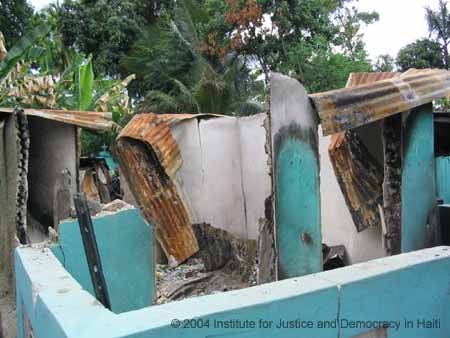

Houses destroyed and burned in Petit Goave on February 29 and beginning March 2004.
Others reported killed include Roro (tortured and then left to burn to death after his house was set on fire), Jonas and Dolando.
Those attacked and injured by Ti Kenley's gang include:
- Toto Telascos from 2ème Plaine who was arbitrarily detained, had his wrist broken and was shot in the leg by the men of Ti Kenley during the week beginning March 8;
- Mathurin whose house was burned in the same week (Monday) and by the same group;
- Pouchon who was shot in both legs by Ti Kenley in March.
On May 31, at least four Lavalas supportersâ houses were riddled with bullets after Ti Kenley was arrested (he was later released). The town police station was attacked and burned during the day. The town police Commissioner has reported that Ostiné's men carried out the attack.
Many other supporters (at least 80) have fled the town after they received threats, including death threats, by members of the gang and other Aristide opponents.
Jéremie
In the commune of Moron, many members of Oganizasyon Ti Fanmi Lavalas have been persecuted by members of the former opposition because of their support for President Aristide. At least six members have been killed while others have had their houses burned. Many have been assaulted and threatened, some with death. The authors of these violations have been named as Crislaine Cadet, Amos Mondesir, "Toutou", Frantz and Navick Adrien, all opponents to the Aristide's regime.
On March 1, the houses of G.S.R.*, V.B. (whose brother was killed by machete blows and afterwards buried by his killer) and Y.J.P.* were burned by Aristide opponents in the area; the houses of C.B., B.R.* and L.M.* have been destroyed by other means in the same month.
All those victims and/or their relatives have fled the area and are now in hiding, in different regions of the country. They cannot go back to Moron as the police are allegedly not acting out against those terrorizing Lavalas supporters.
St. Louis du Sud
Inhabitants of St. Louis du Sud, especially from Cherettes (7th section), in hiding in Port-au-Prince, have reported that many Lavalas supporters have been targeted and persecuted by opposition supporters after the departure of President Aristide. Death threats, and in one case a murder attempt, have been made and several have had their houses burned or destroyed. Relatives have also been threatened or targeted. Information has also been received that the house of Jean Candio, a Lavalas elected Deputé in Cavaillon has been destroyed. Another supporter, O.R., a Lavalas supporter, was beaten and later arrested and detained at the Police Station. There was no police force in the zone and it is unknown who made the arrest.
Threats and Harassment
In addition to the violations described above, a large number of interviewees, in particular members of grassroots popular organizations, have reported receiving specific threats and harassment by supporters of the former opposition because of their support for the constitutionally elected government. Many have been threatened with death if they did not leave their homes, and are now living in hiding. Many of those in hiding are with their spouses and children, which entails severe economic and social dislocation.
The Human Rights Situation in Haiti
The continuing violence and political disturbances in Haiti have resulted in or allowed the commission of numerous human rights violations that in turn generate more instability and cause great suffering in the country. A general climate of fear and terror exists in the country and the number of those killed since February 29 is believed to be high. It is difficult to assess the actual number of political and extrajudicial killings because hardly any criminal investigations have been conducted into unexplained killings and disappearances and other criminal acts, whether political or not.
The investigation carried in Haiti from March to May 2004 reveals that the following prohibited acts have been committed:
a) violence to the life, security, health and physical or mental well-being of persons, in particular murder, torture, mutilation, rape, as well as cruel, inhuman or degrading treatment or punishment and other outrages upon personal dignity;
b) collective punishments against persons and their property;
c) pillage;
d) practicing, permitting or tolerating the involuntary disappearance of individuals, including their abduction or unacknowledged detention; and
e) threats or incitement to commit any of the above acts;
f) arbitrary arrests and detentions;
g) violation of the right to freedom of assembly and association; and
h) violation of the right to freedom of opinion and expression.
The commission of these human rights has involved the use of force and repressive measures by several actors including the government's armed forces and other organized armed groups exercising control over parts of the territory. Acts of violence have been carried out by armed gangs or other criminal groups acting with impunity and what appears to be under the cover, or with the tacit consent, of the authorities. Many of the cases of arbitrary arrests, illegal detention and torture, and of collective punishments against victims and their property are linked to the attempts of the victims to exercise their right to freedom of expression, most commonly while expressing their support for the upholding of democracy.
The violations described in this document amount to gross human rights violations in contravention of international human rights instruments.
These violations are prohibited by the Haitian Constitution and by a whole corpus of international human rights instruments namely the Universal Declaration of Human Rights
[1], the International Covenant on Civil and Political Rights
[2], the Children Rights Convention
[3] and the Convention on the Elimination of Discrimination Against Women
[4] as well as the American Convention on Human Rights
[5] and the Inter American Convention on the Prevention, Punishment and Eradication of Violence Against Women
[6]. Violation of the right to life, liberty and security of person
Those acts of violence committed by the police and by civilian armed groups or individuals constitute violations of article 3 of the Universal Declaration of Human Rights; article 4, paragraph 1, of the International Covenant on Civil and Political Rights; article 4 of the American Convention on Human Rights; and article 19 of the Haitian Constitution.
Violation of the right to protection against torture and other cruel, inhuman or degrading treatment or punishment
Those acts of torture and physical punishment constitute violations of article 5 of the Universal Declaration of Human Rights; article 7 and article 10, paragraph 1, of the International Covenant on Civil and Political Rights; article 5 of the American Convention on Human Rights; and article 25 of the Haitian Constitution.
Violation of the right to protection against arbitrary arrest and detention
The arbitrary detentions constitute violations of article 9 of the Universal Declaration of Human Rights, article 9 of the International Covenant on Civil and Political Rights, article 17 of the American Convention on Human Rights, and article 24 of the Haitian Constitution, which established that the State guarantees the freedom of the individual.
Violation of the right to freedom of opinion and expression
Those actions are contrary to international norms and constitute violations of article 19 of the Universal Declaration of Human Rights; article 19 of the International Covenant on Civil and Political Rights; article 14 of the American Convention on Human Rights; and article 28 of the Haitian Constitution.
Violation of the right to freedom of assembly and association
Actions against this right violate article 20 of the Universal Declaration of Human Rights; article 21 of the International Covenant on Civil and Political Rights; articles 15 and 16 of the American Convention on Human Rights; and article 3 of the Haitian Constitution.
Haiti, as a member of the international community and following ratification of several of these instruments, has a clear obligation to abide by them. Authorities have a duty to investigate violations and to hold alleged offenders of human rights violations criminally or civilly liable in national courts. Even in cases where perpetrators are not state agents the state remains responsible if it is negligent in providing protection, bringing perpetrators to justice and affording effective remedies to victims.
[1] Universal Declaration of Human Rights, G.A. res. 217A (III), U.N. Doc A/810 at 71 (1948).
[2] International Covenant on Civil and Political Rights, G.A. res. 2200A (XXI), 21 U.N. GAOR Supp. (No. 16) at 52, U.N. Doc. A/6316 (1966), 999 U.N.T.S. 171, entered into force Mar. 23, 1976.
[3] Convention on the Rights of the Child, G.A. res. 44/25, annex, 44 U.N. GAOR Supp. (No. 49) at 167, U.N. Doc. A/44/49 (1989), entered into force Sept.2 1990.
[4] Convention on the Elimination of All Forms of Discrimination against Women, G.A. res. 34/180, 34 U.N. GAOR Supp. (No. 46) at 193, U.N. Doc. A/34/46, entered into force Sept. 3, 1981.
[5] American Convention on Human Rights, O.A.S. Treaty Series No. 36, 1144 U.N.T.S. 123 entered into force July 18, 1978, reprinted in Basic Documents Pertaining to Human Rights in the Inter-American System, OEA/Ser.L.V/II.82 doc.6 rev.1 at 25 (1992)
[6] Inter-American Convention on the Prevention, Punishment, and Eradication of Violence Against Women, 33 I.L.M. 1534 (1994), entered into force March 5, 1995.
Contact us: info@haitiaction.org
Contact us: info@haitiaction.org
Contact us: info@haitiaction.org
Click image below for story
Contact us: info@haitiaction.org

